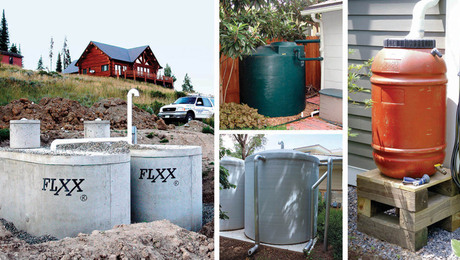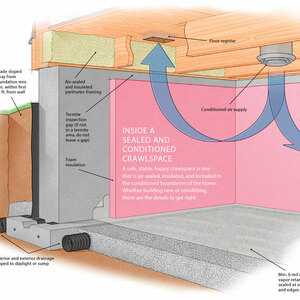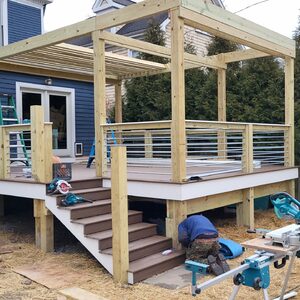Insulate exterior walkway to prevent frost damage to stone foundation?
As most of you probably realize, there is tons of discussion about insulating stone foundations: Do it, don’t do it, inside, outside, rigid, spray foam, etc.
I recognize the importance of protecting my stone foundation from frost damage once the basement is finished. This due to the interior insulation preventing the foundation wall from being warmed by the interior and thus keeping it frost free. One way to prevent this is insulate the EXTERIOR of the foundation using rigid foam, in conjunction with waterproofing.
My basement has been “waterproofed” from the outside, apparently with the brush on coating and dimpled membrane. However, there is no exterior insulation. This got me wondering if I should dig around the house and at least insulate the top couple of feet below grade as this is the most susceptible to frost. I then thought, perhaps there is better way, which would require less digging.
Since the walkways around the house need to be replaced anyway, I was wondering if I could combine the two jobs. Here’s what I’m thinking. I’m in downtown Toronto (Ontario, Canada) and there is another house two feet away on one side and three feet on the other. Does it make sense to redo the walkways much the same way I’m redoing the basement floor slab, by putting down 2″ XPS beneath the sidewalks?
This way the entire soil area between the houses is protected from freezing, thus preventing any frost in the foundation walls. Especially since much of the moisture should be prevented from getting in the wall in the first place by the waterproofing membrane. This probably wouldn’t work in the suburbs but does it make sense here where there is such a narrow strip of soil which can be “fully” insulated. This method would be very simple and cheap, essentially just the cost of the XPs, as all the other work is being done to replace the walkway anyway.
What do you think? I can’t see how it would hurt anything even it it doesn’t fully protect the foundations, surely it is better than what I have now.


















Replies
It seems like your logic is very sound. I question the need if you already have a drainage layer/material anyway against your wall which will have a tendency to dampen any expansion. An since your soil amount (3 ft) is small anyway, it may not be an issue.
Expansion is due to water ... Key is water management. Your description raises a little concern about good water drainage. If you are confident the drainage is good (incl roof gutters), then there may be no issues. Is your neighbors house roof draining between the houses or is it guttered well?
Hopefully someone else will interject w/ more thoughts. I'm NOT an expert in this area.
Thanks for your input. It does seem to me that almost all of the moisture problems are taken care of. All the gutter drainage is away from the houses, and not onto the walkways or against the walls. The foundation has been waterproofed. Plus the soil is all lovely clean sand, which is apparently NOT that susceptible to frost anyway. So I *think* I'm in reasonably good shape. Perhaps I'm being too paranoid but since the cost and effort is SO small to do this extra step it seems it would be worth it. As long as I'm NOT causing other problems...................
Doesn't seem like you would cause problems. The houses are so close together the two influence each other ... with respect to the temperature gradient. The ground will actually be warmer than it might otherwise be. I think your idea is very reasonable the more I think about it. You will probably do more energy wise than any freeze protection.
There are many who advocate horizontal rather than vertical insulation for foundations and footings -- go down a foot or two (below the level where the insulation is apt to be damaged) and then jut off horizontally with the foam. This (obviously) keeps the ground below warmer. In theory it will prevent frost heaving damage to foundations when simple vertical insulation won't, plus it will be effective (though not AS effective) at warming the foundation wall itself.
I did just think of one possible downside. Any water that gets into the slab (control joints, slab edge, etc.) will not be readily able to drain away because of the XPS. Will this cause premature failure of the slab itself (NOT the foundation wall) due to frost heave etc.? I would imagine it will only be a small amount of water getting in, but some will, what with rain and snow melt. Probably not a whole lot worse than small amounts of water getting in these locations anyway, but.........................
What do you think?
Thanks.
I don't believe that effect would be all that dramatic. Concrete is often pretty wet in the winter anyway.